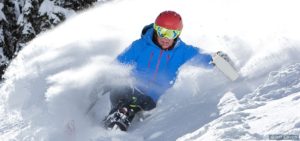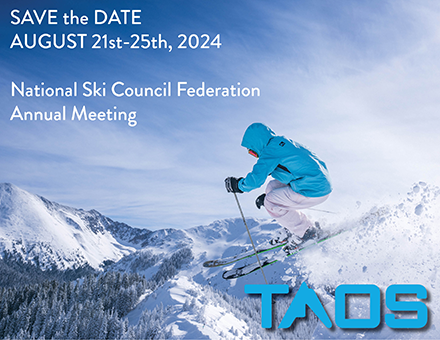 Martinson, seen here in March 2016, will be inducted into the U.S. Ski and Snowboard Hall of Fame on April 9.
Martinson, seen here in March 2016, will be inducted into the U.S. Ski and Snowboard Hall of Fame on April 9.
Jim Martinson’s equipment innovations opened up new worlds to multiple generations of aspiring athletes — but there was an ulterior motive along with the altruism.
“I wanted more people to compete against,” he confessed.
That meant everywhere — on his home slopes of Crystal Mountain in Washington, on the road through Natick and Wellesley at the Boston Marathon, or under the Paralympic flag at Albertville, France. In the process, he became a godfather of sorts in the adaptive sports world.
But at the same time, he was all about the race.
So take your pick — contributor or competitor. In either role, Martinson is a worthy addition to the U.S. Ski and Snowboard Hall of Fame, which adds a seven-person class on Saturday during ceremonies in Aspen, Colorado.
Martinson thought he’d left his ski-racing ambitions behind when a landmine explosion on a Vietnam battlefield took away his legs back in 1968. Time and his own determination have proven him wrong.
“I would never have believed for a second that I’d be able to ski after what happened to me,” said the 69-year-old Martinson. “To be in the Hall of Fame, that’s just unreal.”
And yet he’s already played a role in others getting there. Hall of famers such as Sarah Will and Chris Waddell piled up multiple Paralympic gold medals on Martinson’s iterations of the “Shadow” mono-ski. But even more important, that breakthrough opened the door for countless recreational snow enthusiasts to enjoy the sport.
That’s all Martinson had in mind for himself as a kid at Crystal Mountain, where he was a pretty fair racer.
“How good I was, I’m not sure,” he said. “I just knew I wanted to be involved in skiing — ski patrol, manager, instructor, cat driver. Anything.”
A draft notice interrupted that. He’d been in Vietnam for five months — and just promoted to sergeant — when a member of his platoon tripped the explosive during a supply run. Five days later, Martinson woke up in a Yokohama hospital with no legs “and no clue what I was going to be.”
There was anger and depression, and some self-destructive partying. Eventually, Martinson found his way back to school, and through some friends onto a basketball court with the Tacoma Wheelmen. That piqued both his competitive urges and his innovative ones — he and teammate Jim Hernandez collaborating to build competition wheelchairs that were less than half as heavy as the clunky 60-pounders everyone was using. That segued into a racing phase that saw him win the 1981 Boston Marathon (he would also finish second three times) and claim Paralympic track gold medals in 1980 and 1984.
But always, the mountain was calling.
“I’d take my kids up and do the thing I said I’d never do — sit in the lodge and wait all day for skiers,” he recalled.
He was introduced to the Mono Bob, but was frustrated that it couldn’t be used without assistance. So he took it into the shop, cadging a shock from dirt-bike technology and developing what would become the Shadow — a mono-ski that allowed users to get on and off the chairlift independently. His early runs in the trial and error phase were every bit the thrill his gold medal runs would be later.
“It was totally a dream come true,” Martinson said. “I was only up on real light intermediate hills, but I tell you, it was incredible. I’d fall down, get back up, fall down again and go back and tinker a little bit and figure things out.
“I never really realized what I was doing. I never thought the product would get to the level it is today. I’ve heli-skied in Alaska, done the X-Games jumping 60 feet in the air and raced in the Paralympics going 60 miles per hour downhill. Pretty amazing from those meager first days.”
By this time, his company Magic In Motion was manufacturing the gamut of adaptive equipment — chairs for racing, basketball, tennis, golf, rugby, as well as his Shadows. He sold the company for $2.5 million in 1992, though he stayed on until 2000.
And the competition, well, he kept on with that, too.
In 1992, he won downhill gold in the Albertville Paralympic Winter Games — despite putting on “a whole bunch of weight” from the wine-and-cheese breakfasts he shared with Waddell. And at age 63, he was lured into the X-Games — though all he got out of that was a broken clavicle and scapula.
“It’s been incredibly fulfilling, getting back to something I loved forever, but also to know the impact it’s had,” Martinson said.
“There’s a games in Colorado the Veterans Administration puts on, and when I was back there two or three people came up to me skiing on mono-skis wanting to say thanks for making this possible and saying it’s changed their lives. That’s what it’s all about. You see people like Chris and Sara achieve what they have and it’s exciting to think you might have had a little bit to do with that.
“That’s pretty special.”
John Blanchette is a sportswriter from Spokane, Washington. He is a freelance contributor to TeamUSA.org on behalf of Red Line Editorial, Inc.
Team USA.org



